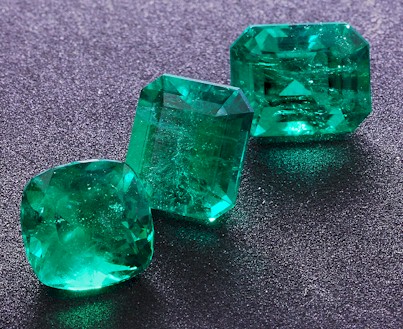The synthesis of Emeralds began in the 1930s with the Farben (Igmerald) and the Chatham processes. These were flux process synthetics, created by dissolving gem nutrients in a molten flux, and allowing crystallization on a seed of natural Emerald or Beryl. These did not become widely available until the late 1940s, while technique refinements were taking place. Most of the synthetic Emeralds produced in the 1940s and 1950s were of limited size and quality.
 Hydrothermal synthesis has been undertaken successfully by many different scientists at various times for a period of more than one hundred years. Perhaps the man who contributed most to the advancement of this technique, and to whom later workers owe the greatest debt, was an Italian named Spezia. His work led the way to the efforts of the I.G. Farben group in their production of synthetic emerald in the early to mid-1930s, to those of the Bell-Laboratories in synthetic quartz, and presumably, to Gilson, Chatham and Linde's initial efforts as well.
Hydrothermal synthesis has been undertaken successfully by many different scientists at various times for a period of more than one hundred years. Perhaps the man who contributed most to the advancement of this technique, and to whom later workers owe the greatest debt, was an Italian named Spezia. His work led the way to the efforts of the I.G. Farben group in their production of synthetic emerald in the early to mid-1930s, to those of the Bell-Laboratories in synthetic quartz, and presumably, to Gilson, Chatham and Linde's initial efforts as well.
In the 1960s, a new method of hydrothermal flux synthesis was applied to Emerald creation. This method is largely used today in the creation of synthetic Emeralds. The technique involves dissolving the crystal nutrients in an acidic solution of water and chemicals at high temperatures and pressures, with crystallization occurring in a cooler chamber in the reactor. These early versions of the present-day hydrothermal Emerald creation were known as Emerita and Symerald.
Lab-created or synthetic emerald material can be created by placing a beryl seed in a sealed, pressurized container. The container is filled with extremely pure water. A nutrient containing crushed emerald and other compounds such as vanadium and chromium is introduced into the hydrothermal environment and an electrical charge is passed through the chamber to ionize the environment and the unit is slowly heated in an autoclave. As the heat and pressure build in the sealed environment, to about 1800 degrees Fahrenheit and 800psi, the environment reaches equilibrium and the molecular de-stasis process begins. Molecules of the nutrient are stripped away and are attracted to and reform on the larger and more solid emerald seed. These crystals grow at a rate of approximately 0.15mm per day, so a large crystal takes many weeks to form.
Chatham claims to start with commercial beryl of an essentially colorless type and to add a certain amount of chromium oxide to the flux from which the crystals are grown. It would seem from this that the use of low-grade beryl accomplishes the purpose of furnishing the feed stock without requiring the long and involved purification and calcination of the powders required by the Verneuil method. The color of the best Chatham stones is an attractive deep green that resembles fairly closely some of the top-quality Muzo emeralds, but they tend to be even more bluish than these natural stones.
The Chatham crystals today are characteristically well-developed hexagonal prisms or groups of prisms, frequently with concave faces. Chatham is now producing in commercial quality, and a production in excess of 15000 carats per month is available, including gem-quality cut stones in excess of six carats and fine quality faceted stones over ten carats. He is also experimenting with a variety of beryls of other colors, less from the consideration of possible commercial production for gem purposes than for use in science.
By 2000, the annual global production of synthetic emerald was over 600000 carats. The flux and hydrothermal synthesis of Emerald today remains the primary means of creating Emeralds. Manufacturers of recently produced synthetic Emeralds include Biron, Chatham, Kyocera, Gilson, Inamori, Farben, Lechleitner, Linde and others.

Colombian emeralds will typically be the most expensive followed by Brazilian and Zambian stones. The reasoning is related to the color. Colombian emeralds get their color primarily from the trace amounts of the element chromium which is responsible for some of the purest greens in gemstones. Brazilian emeralds get their color primarily from trace amounts of the element vanadium and Zambian emeralds get their color from iron. Brazilian emeralds typically have a slight brown or gray cast and only sometimes match the pure green hue that many Colombian emeralds offer and Zambian emeralds often appear too blue due to their iron content. In reality though, emeralds from all three sources may be colored by more than one element.
All trademarks and logos shown herein are the property of their respective owners. © Copyright Multicolour Gems Ltd, 1998-2001. All rights reserved. Use of this site constitutes acceptance of Multicolour Return Policy, Privacy Policy and Trading Guarantee. Multicolour.com headquarters at # 59 Soi Pradit, Silom Soi 20, Bangkok, 10500, Kingdom of Thailand, Tel: +66 2 233-2108, Fax: +66 2 236-5274, E-mail to info@multicolour.com. Lost? Check Site Map. Site design and maintenance by NetComposite ®.
|